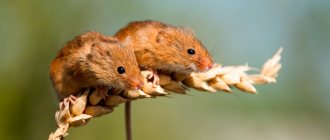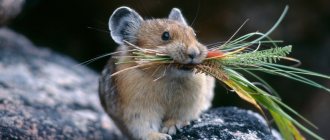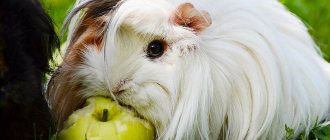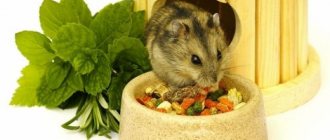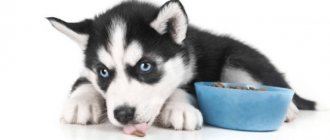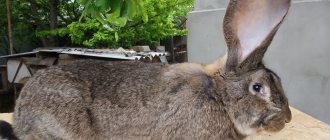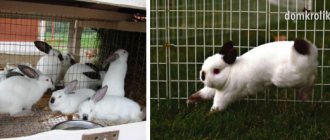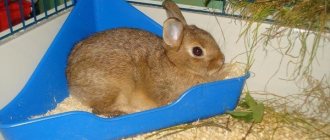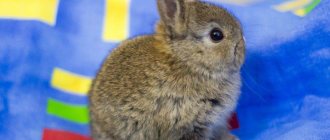The digestive system of rabbits is well developed. The main process of digestion takes place in the colon and cecum, the size of which makes up 40% of the total volume of the gastrointestinal tract.
Food does not require special expenses. It should be based on fiber, essential minerals and vitamins. Also, the diet of rabbits differs at different times of the year. The animal should be fed several times a day in small portions, and there should always be fresh water and hay in the cage.
Main types of feed
Experienced breeders will be able to easily answer the question - what to feed rabbits? However, for beginning farmers, not everything is so simple. Animals' menus should include a variety of vegetables, herbs, grains and mixed feed.
All food can be divided into several types:
- green;
- rude;
- juicy;
- concentrated.
Each type of feed has its own characteristics and requires proper feeding. While some foods can be given raw, others can only be given boiled.
Green food for rabbits
As soon as the first shoots of plants appear in the spring, rabbits can be given green food.
They must be present in the animal’s diet and include:
- Wild herbs. Please note that not all of them are suitable for feeding rabbits. It is best to harvest them in natural meadows. If possible, you can grow the necessary herbs on your site. Suitable for this purpose: lupine, clover, alfalfa, oats, barley, corn.
- Vegetable tops and cabbage. The tops of rutabaga, Jerusalem artichoke, potatoes, fodder or sugar beets, and turnips are suitable as such green food. If you choose beet tops, you should feed them no more than a third of the total amount of green feed. It has a laxative effect. Along with it, oak leaves and branches, which have fixing properties, should be added to the feed. Alder, comfrey or yarrow are also suitable.
- Seeded legumes and grain grasses. They are beneficial for rabbits due to their high protein and vitamin content. However, feeding them alone will lead to bloating, so they need to be combined with other types of food.
Despite the fact that potato tops are allowed for rabbits, they should be given with caution. To do this, it should be mowed 4–5 days before the planned harvest. Introduce it into the food gradually, adding a little at a time.
Rough feed for rabbits
When choosing what to feed your rabbits, do not forget about roughage. These include: hay, straw, branches of some trees. They help improve the digestion of rabbits and additionally grind down teeth, which is also necessary for furry animals. They will happily gnaw the bark from the branches and will not damage the cage.
Young branches of raspberry, acacia, linden, willow, apple and aspen are best suited. This is a favorite treat for rabbits.
It is worth highlighting hay as the main element among roughage. It must be harvested from the same types of green plants that rabbits eat in the summer. It should be mowed before the grass begins to bloom. After this, it must be left in the sun to dry thoroughly for several days. Even dry hay still needs to be dried under a canopy so that it does not rot later. It should be stored indoors on wooden floors.
If the weather is rainy for a long time during the hay harvesting period, then you need to mow it in small areas. After this, it should be laid out in thin layers on shelves made of metal mesh or on wooden slats. Don’t delay cutting hay for feed. If the grass gets too rough or sits in the rain for a long time, rabbits will have trouble eating the hay. If you manage to prepare hay only in rough form, then it is better to grind it into flour. When receiving it along with other food, animals will eat it with pleasure.
For one adult rabbit you need to prepare about 45 kg of hay. This amount should be enough for the winter. If you plan to have offspring, then you should stock up on hay for the babies. 10–15 kg per baby rabbit will be enough. If there is not enough hay for the winter, then first of all it should be given to lactating females.
Branches, like hay, can be stored for the winter. They will be a good source of vitamins during the cold season. To harvest them, branches from suitable trees should be well dried. It is most convenient to do this under the roof of a shed, where good ventilation of such roughage will be ensured. In addition, in winter you can feed your pets with fresh spruce or pine branches. They will help increase appetite and have a beneficial effect on the coat. The only thing is that you need to give them in small quantities and take breaks.
What succulent food can you feed rabbits?
If at the beginning of summer most of the rabbits' diet consists of green food, then later the grass begins to turn yellow and there is not enough of it. During this time, you can give your rabbits a variety of root vegetables. Melon crops are well suited. They will love pumpkins, zucchini and watermelon. These foods are rich in vitamins. The only thing is that they are low in protein and fiber, so they need to be given in combination with other foods.
A nursing rabbit needs more vitamins than a normal rabbit, so she needs to eat root vegetables. In addition, succulent foods help increase milk supply.
It is important to know the best way to feed certain foods. It is better to give carrots to rabbits in a raw state, after washing them well from the soil. You can put it in cages whole or cut into pieces. Rabbits will happily chew on it. Cabbage can be given either fresh, boiled or pickled. However, to prevent digestive disorders, introduce it into the diet gradually and little by little. Zucchini can be given raw. They promote better absorption of other feeds. Pumpkin is given both raw and boiled. Small rabbits can make puree from it. It also helps increase growth and promotes greater milk production in nursing rabbits.
Silage is of great importance in feeding succulent feed. It is prepared from grass, tops, vegetables and melons. The more ingredients there are, the more nutritious and healthy the food will be. Silage, which contains a mixture of beets, tops, cabbage and carrots, is well digested by rabbits.
To prepare silage, you need to chop all the ingredients into small pieces and then compact them thoroughly. It is advisable to do this in large pits with a wooden frame on all sides. You can also use a wooden barrel for this. By placing the crushed ingredients in the pit, it is necessary to limit the supply of oxygen. To do this, cover everything with film and then sprinkle it with a layer of earth and straw. Such food will be ready only after 1.5–2 months.
Concentrated feed for rabbits
Despite the beneficial properties and nutritional value of green and juicy food, rabbits must also be given concentrated feed. These include:
- cereals;
- bran, cake, meal;
- legume grains;
- compound feed;
- animal feed.
Due to the high protein content and small amount of water, concentrated formulations have a high energy value. They help rabbits grow faster and more intensely. In nursing rabbits, they help increase milk production.
Oats, corn, rye, barley, wheat, peas, beans, and lentils are good choices for cereals and grains. It is desirable that 30-40% of the daily diet consist of concentrated feed. It is also important to know how to properly give such food to rabbits. Thus, oats can be fed to animals in the form of whole grains, crushed or flattened. It contains many nutrients, but is considered a dietary food. You can often feed grain to rabbits without fear of their obesity. It will have a good effect on intestinal motility.
It is better to give corn to rabbits soaked or crushed. In addition, you can cook porridge from it, which the animals will also like. This product is especially useful for fattening rabbits. It can be combined with legumes, which contain a lot of proteins and amino acids.
Wheat, barley, sorghum and rye should be given in crushed form and better mixed with other types of feed. There is no need to give them in large quantities. This may lead to bloating.
You should not neglect feed. It has a balanced composition that allows you to satisfy all nutritional needs. There is a special concentrate for rabbits, which is made in the form of small and large granules. With its help you can replace all other types of concentrated feed. However, this will be a more expensive meal, which will hit your pocket. It will also help raise animals faster.
When choosing feed, you need to take into account the age of the rabbits. There are mixtures intended for young individuals from 1 to 3 months, and there are also up to 6 months. Larger rabbits can be given any type of food.
Feed groups
The rabbit diet must be selected so that the nutrition is balanced and varied, and the food is rich in vitamins and other nutrients. So what should you give your rabbits? The following groups of feeds are distinguished.
Greens
Meadow grasses and the kind of greenery that grows in the garden in the village. This is the most inexpensive way to feed rabbits, which provides them with healthy food for a fairly large period of the year - from spring to late autumn. Rabbits receive the vitamins and minerals necessary for growth and further reproduction.
For owners of small livestock, a small summer cottage will be enough to feed them if they sow some peas, alfalfa, quinoa, and cilantro there. Another thing that rabbits eat is corn. What rabbits eat most readily is the tops of root crops. Common weeds are good for feeding rabbits: nettle, burdock, wheatgrass.
Any vegetation from the garden must be thoroughly cleaned before entering the feeder. Under no circumstances should you add rotten or too wet greens to your food. This can cause the animal to become sick.
Rough
Dried herbs are no less beneficial for rabbits, and may even top the list of what to give to rabbits. This group includes straw and small branches. They are given to animals from late autumn to early spring.
Hay is considered one of the main sources of nutrition that improves digestion. For a good diet, dried grass can be given, mowed in meadows or steppes. It is useful to add twigs of bushes and trees to a rabbit's diet, since animals have one peculiarity - a constant need to grind down their incisors.
In terms of its energy value, food from branches is no worse than hay made from medicinal herbs, since it is enriched with protein, amino acids, as well as carotene, and there is a complete set of minerals and fats.
Feeding from branches helps reduce disorders associated with the gastrointestinal tract in animals. Oak or alder will do, but you don’t need a lot of birch branches, as they provoke kidney inflammation in rabbits.
Juicy
Juicy food is most easily absorbed by the body of their pets and is quickly digested. This is explained by the fact that they contain up to 80% water. They contain substances necessary for the growth and health benefits of rabbits: fiber, carbohydrates, vegetable fats, a rich composition of vitamins and mineral components. The category of juicy includes such vegetables and fruits as beets, cucumbers, potatoes, radishes, pumpkin, onions, carrots, garlic, zucchini, pumpkin, watermelon, banana, apple, etc.
Despite the fact that there are not many vitamins in the composition, potatoes contain starch that is easily digestible by the rabbit’s body.
Before feeding the rabbits, the potatoes need to be thoroughly washed and boiled. It is rarely given raw, and it is not the tubers that are used for food, but the peelings.
When feeding rabbits, only sugar and fodder beets are used. You can add both tops and tubers to the mash. The vegetable is rich in beneficial substances such as proteins and fats, which helps improve blood composition.
Of the things that rabbits eat, cabbage is perhaps one of their most favorite delicacies. But excessive consumption can lead to bloating. Cabbage contains enough vitamins, minerals and fiber that animals need for growth and replenishment of offspring.
Carrots contain enough beneficial essential oils, fatty acids and minerals. Eared ones are usually given raw carrots, whole or cut into slices.
Feeding pumpkin to rabbits is considered beneficial. It is rich in vitamins. It is usually given from autumn to early spring, since the vegetable is suitable for storage in winter. The pumpkin is most often cut into small pieces and only then placed in the feeder.
Zucchini is given in summer and autumn due to its extremely short shelf life. It contains a sufficient amount of water beneficial to the body. And in this case, less drinking water should be added to the drinking bowl.
After preparing for the winter, many people are left with waste. Is it possible to give rabbits potato peelings, cabbage leaves, watermelon rinds and banana peels? Of course, this is exactly what rabbits love. In addition, banana peels are very useful due to the presence of vitamins and fiber in their composition, but the bananas themselves are produced exclusively fresh and in small quantities.
Additional Information. Contrary to popular belief, rabbits love garlic; it is beneficial for rabbits, as it is an effective means of preventing rhinitis.
Concentrated
They are high in calories and enriched with proteins and minerals. But the amount of microelements in them is much less compared to other types of food. Concentrated feed is recommended for those rabbits that are raised directly for fattening: cereals (oats, barley, buckwheat), compound feed, legumes, bone and fish meal.
What should rabbits be given from concentrated feed? Breeders should pay attention to grain crops:
- Oats are rich in protein, starch, fiber and fat. Oats are given to rabbits both whole and in crushed form.
- Buckwheat is a valuable source of energy and vegetable protein. Thus, it allows the animals to actively grow.
- Corn is much more nutritious than oats. But for the animal’s incisors, corn is quite hard, so it should be soaked before serving to rabbits.
- Wheat is rich in phosphorus and other useful elements. Most often mixed with fresh grass, as well as roughage and succulent food.
Among the things you can feed rabbits, oats are especially beneficial. This cereal helps to normalize the animal's intestinal activity. Moreover, it can be used in feeding rabbits of any age group.
Concentrated feeds include compound feeds, which have become very popular. Animals love to feast on both loose and granulated feed. Components that are beneficial for rabbits are most often added to it, and it can also be used in conjunction with various medications.
What to feed rabbits so they get vitamins and minerals
Vitamins and minerals play an important role in feeding rabbits. They must be present in the diet. If in the warm season rabbits receive the necessary vitamins from green and juicy foods, then in winter they become much smaller. In this case, special supplements will help replenish them.
Essential vitamins
In order for rabbits to receive vitamin A and D, they need to add fish oil or animal vitamins in concentrated form to their food.
It is worth considering that fish oil standards differ depending on the age of the rabbits, as well as their activity:
- small rabbits will need 0.3–0.5 g each;
- adult individuals who are at physiological rest can be given 1 g;
- rabbits who are preparing to become mothers and nursing mothers need more vitamins - about 3 g each.
The most important vitamins for rabbits include:
- B vitamins promote good digestion and blood formation. They have a positive effect on the nervous system. Important for little rabbits.
- Vitamin C has a good effect on digestion and improves immunity.
- Vitamin A improves the nervous system and makes rabbits calmer. It also affects reproduction.
- Vitamin E is needed for the heart and strengthening muscles. The need for it is especially high in winter. It is found in good hay, grass and baker's yeast;
- Vitamin K – necessary for the formation of the reproductive system;
- The skeletal system of animals requires vitamin D.
Essential Mineral Supplements
Mineral supplements are also necessary for rabbits. Their role can be: bone meal, bone ash and chalk. Some rabbit breeders prepare their own bone meal.
Salt is an integral element of nutrition. It contains essential minerals. It has a beneficial effect on all vital processes of animals, and also improves the metabolic process. In addition, salt will strengthen the immune system. For young animals you will need 0.5–1 g of salt per day, and for adult rabbits 1–1.5 g. It is better to give lick salt.
Nutritional supplements
You can compensate for the lack of vitamins with the help of nutritional supplements. The most popular of them include:
- Chiktonik is a supplement for the rapid growth and proper development of rabbits. It is available in liquid form. It must be added to water in a ratio of 2 ml of solution per 1 liter of water.
- Gammatonic is a supplement with a large amount of amino acids and trace elements. It also comes in liquid form and is added to water.
- Prodevit – contains the necessary vitamins A, D and E. It comes in the form of an injection solution, but you can also add it to food. In this case, two drops per day will be enough.
- E-Selenium is also an injection solution. It includes vitamin E and selenium. Good for food poisoning and infertility.
When adding food additives to food, the main thing is not to get carried away. You should not exceed the prescribed norms, because rabbits also get vitamins from other foods.
Some vegetables
In addition to the main food, some vegetables, fruits, grains, beans and even berries can be added as variety and additional food. However, it is important to remember that these supplements should be introduced into the diet little by little.
Fruits
It should be noted right away that various exotic fruits (bananas, pineapples, mangoes, figs, etc.) are completely unnecessary for rabbits, since in the wild they have nowhere to get them.
Essential fruits include dried apples, raisins, pears, and grapes (seedless).
Cereals
The grain contains a large amount of useful substances. The main useful grains for rabbits are:
- oats - has a beneficial effect on the entire body;
- wheat - has a high energy value;
- corn - contains carotene, as well as B vitamins;
- barley - has a beneficial effect on the digestive system.
Legumes
Legumes also have a beneficial effect on the digestive system, however, there is a possibility of gas formation, so it is necessary to feed your pets legumes in moderation.
Most often the diet contains:
- peas;
- beans;
- beans.
They must be given in crushed form or whole, pre-soaked in cold water for about 3 hours (so that the legumes soften and are easier to eat).
Berries
In addition to fruits and vegetables, some breeders recommend feeding long-eared pets with berries. Permitted fruits include:
- strawberries;
- blueberries;
- currants;
- raspberries
The berries contain a large amount of vitamins and microelements, but it is not advisable to give them to rabbits more than several times a week.
Did you know? In their natural environment, rabbits eat a lot of grass, fruits and vegetables. In one day, the grass eaten by the male could fill an average pillow.
What to feed rabbits depending on the season
Feeding rates for rabbits depend primarily on the season. When raising animals for meat, it is important that they grow well and quickly. It will not be possible to feed rabbits the same all the time, because in summer there is much more green food, as well as branches and grain. During the winter, rabbits need much more energy so that they can maintain a suitable body temperature.
In the summer, one adult rabbit will need 40–50 g of concentrated food in combination with roughage. In addition, every day you need to give the animals half a kilo of green feed. When females are preparing for mating, they will need a larger diet. So, the norm of concentrates needs to be increased from 50 g to 70–80, and green grass to 600 grams. Pregnant females should also be fed approximately within these limits. Nursing rabbits will need at least 1 kilogram of greens and 150 g of roughage.
In winter, you need to be more careful when choosing food for rabbits:
- You should include succulent food and hay in your diet. For adult individuals, you need to allocate 150–200 g of juicy and 150 g of hay.
- In preparation for mating, you need to add about 100 g of concentrate and roughage to the diet.
- If the rabbit is expecting offspring, the succulent food should be increased to 250 g, and the coarse food to 130 g.
- When feeding babies, the female should be given 350 g of juicy and 150 g of concentrated food. Don’t forget about hay, which will require about 250 g.
When raising meat breeds, you should increase the amount of concentrated feed, as well as bran and root vegetables. This is especially important in autumn and winter. Young rabbits require a little less food, but it should also be varied.
Rabbit diet
Feeding rates depend on the season, the condition of the rabbits, as well as their species. The feeding pattern of a domestic ornamental pet will differ from the feeding of agricultural breed rabbits.
Diet of agricultural breeds (meat and fur)
In summer, one rabbit needs 40-50 grams of concentrated and roughage food plus half a kilo of green food. During preparation for mating, the amount of food increases: green for 600 grams, concentrated and coarse - 70-80 grams. For a pregnant female, you will need 550-700 grams of greens and 70-90 grams of concentrated and coarse ones. A nursing female needs at least a kilogram of greens per day and up to 150 grams of roughage.
In winter, the basis of the diet is succulent food (150-200 grams) plus hay (120-150 grams). The amount of roughage and concentrated feed remains the same. During preparation for mating, 150-200 grams of juicy, 90-100 grams of concentrated and coarse hay and 150-200 grams of hay. A pregnant rabbit needs 200-250 grams of juicy hay, 100-130 grams of coarse hay and 150-200 grams of hay. A nursing female will need 300-350 grams of juicy hay, 140-160 grams of concentrated and coarse hay, and 200-250 grams of hay.
Fattening of meat breeds usually occurs in autumn and winter. When fattening, the amount of concentrated feed, bran and root vegetables (especially boiled potatoes) is gradually increased.
Diet of domestic decorative rabbits
In decorative pets, digestion works worse than in agricultural breeds. Therefore, the issue of their nutrition should be treated especially carefully and responsibly.
Decorative eared animals can be given the following foods.
- Hay is the main food for ornamental breeds. It must always be present in the cell. Hay should be kept clean and dry and replaced as needed.
- Grass – it can be added to the diet in the summer. It is advisable to collect grass away from roads and other sources of pollution.
- Granulated food - sold in pet stores, contains vitamins and microelements. Most pelleted foods should be fed two tablespoons per day.
- Vegetables and fruits can be given a little at a time, in small pieces and only washed and fresh. Too many vegetables and fruits can upset the digestive system of the decorative eared cat. Radishes, parsley, carrots are good options. It is better to exclude beets and cabbage to avoid stomach problems.
The following are strictly prohibited for decorative breeds:
- sweet and flour;
- potatoes – both fresh and boiled.
Both lead to obesity and shorten the life of the pet.
Also consider feeding features:
- When feeding your pets succulent food and mash, make sure that food does not remain in the feeders. Half an hour after eating, wash the rabbits' bowls and next time try to give portions of such a size that the rabbits eat them completely, but do not remain hungry.
- Follow the feeding schedule: when food is served at the same time, animals do not attack it, and not only eat the food better, but also absorb it more fully.
- Transfer your pets to a new type of food (especially with the change of season) gradually so that the animals’ bodies can adapt.
As for fattening, you can fatten both young animals from three months and already adult animals. Rabbits fatten quickly - even one month is enough. First, during the first ten days, the share of roughage in animals is reduced, bringing the volume of concentrated feed in the diet to 50%. Then the animals are fed nutritious feeds that promote fat deposition: oats, peas, barley, corn, cake, mash with boiled potatoes and bran. Root vegetables are completely excluded from the diet, and the amount of hay is reduced to a minimum.
The maximum amount of food occurs in the last ten days of fattening. Grain mixtures, mash with mixed feed and bran, twig food and aromatic herbs that increase appetite (chicory, dill, cumin). Hay is given only in case of indigestion, and succulent and roughage is not given at all.
Fattening is more efficient when they are seated one at a time in cages. And due to the fact that these animals prefer to eat more at night, the windows in the rabbitry are specially darkened, reducing daylight hours to eight hours. By the end of fattening, the animals become well-fed, inactive, their fur acquires shine and silkiness - which means they can be sent to slaughter.
Rabbit feeding regimen
When choosing what to feed rabbits, you need to take into account that not only the diet is important, but also the feeding regimen. Fluffy animals eat little by little, but often. They can go to their feeders more than 30 times a day. It is advisable to feed them at the same time. In this case, they will produce gastric juice at the time of feeding. Thanks to this, animals grow faster and develop more quickly.
Adult rabbits need to be fed 2-3 times a day. Nursing rabbits and their babies need to be fed 4 times a day. You can adhere to the following regime:
- With three feedings a day in the winter season:
- 8 a.m. – give half the norm of concentrated feed and hay;
- 12 hours – give succulent food;
- 17 hours - give half the norm of concentrated feed and the same amount of roughage in the form of branches and hay.
- With three feedings a day in the summer:
- 6 hours – combine half the norm of concentrated feed with 1/3 of grass;
- 15 hours you can give rabbits 1/3 of the norm of green food;
- 19 hours you can give half the norm of concentrated and 1/3 of green feed in addition to roughage.
- With four feedings a day in the winter season:
- 6 hours – give the rabbits 1/3 of the concentrated feed and ¼ of the hay;
- 11 hours – you can add another half of the norm of succulent feed to 1/3 of the concentrates;
- 16 hours – give ½ of the hay and the other half of the norm of succulent feed;
- 19 hours – give 1/3 of the concentrates and ¼ of the hay. Before going to bed, you can feed the branches.
- With four meals a day in summer:
- 6 hours - you need to dispense a third of the concentrates and ¼ of the herb;
- 11 o’clock – you can give the same part of the concentrated feed and the same amount of green;
- 16 hours – you can give only half the amount of grass;
- 19 hours – you should feed the rest of the concentrates and ¼ of the green feed, as well as branches.
This is just a sample feeding schedule. You need to create your own time schedule, taking into account the available feed. The main thing is to learn to stick to one feeding time and give a variety of foods.
Differences in feeding rabbits in winter and summer
Feeding in summer
What do rabbits eat in the summer? The basis of nutrition for these animals in summer includes green grass and tops from the garden (radish, carrots). They eat twig food very willingly. These can be branches of fruit and deciduous trees. Brooms from tree branches can be prepared for the winter. Domestic rabbits eat cabbage, apples and their waste.
How to give beets and how much? Red beets and sugar beets should not be given in large quantities. In large quantities, it causes gastric tympany (bloating). Fodder beets can be given ad libitum. The beets are chopped or sliced. Include bitter aromatic herbs in your diet - wormwood, chicory, yarrow, tansy (little by little), dill. They have an anthelmintic effect and enhance digestion. To prevent stomatitis, you can give dried garlic stalks. Plantain is a natural antibiotic.
Nettle is the first herb to appear in spring. After winter, the rabbit eats its first treat with appetite. To feed the nettles, you must first prepare them: cut and mash them, let them sit. This is how its pungency is lost.
Young branches of willow trees with the first buds and leaves serve as an excellent transitional food from the winter diet to the summer feeding. A sudden transition can cause digestive upset.
Feeding in winter
When winter approaches and the amount of green food decreases significantly, the animals on the farm are switched to winter food. Feeding rabbits in cold weather has its own characteristics. Food for rabbits in winter conditions consists of hay and root vegetables, kitchen scraps, and concentrates with mineral supplements. At the end of October - beginning of November, the animals are fattened for meat. Part of the hay is replaced with twig food. Properly prepared brooms contain many vitamins. Giving branches is necessary to grind down the incisors, otherwise the rabbits will chew the cages.
It is not recommended to feed raw and dirty potatoes. It is better to wash it, boil it and give it mashed in the form of a mash. In winter, food should be given dry so that it does not freeze, and food that is difficult to chew (waste of lentils, vetch, peas, corn) should be pre-soaked. Lightly moisten the feed and bran with salt water. Add boiled potatoes or grain. Beets and carrots are washed and cut into pieces. Rabbits eat chopped root vegetables better than whole ones.
Beginning rabbit breeders often ask themselves: what should they not feed rabbits? This is sour, moldy or musty food. The topic of “can rabbits eat bread” is also controversial. Fresh bread is harmful to digestion and it is better to give it dried. Another question concerns beginners: “can duckweed from a pond be given to rabbits?” Duckweed is a valuable food, but if the pond is infested with parasites, is it worth the risk? In winter conditions, water often freezes. It is not always possible to keep an eye on the drinking bowls. Therefore, you can give snow or ice. To prevent vitamin deficiency, conifer needles should be given. At first, the pet eats them reluctantly, but then gets used to it.
Dangerous and poisonous food for rabbits
Despite the fact that rabbits can be given a wide variety of foods, there are also foods that are contraindicated for them. Animals are very sensitive not only to the quality of food, but also to its individual components.
Dangerous herbs
Rabbits should not be given:
- Wild herbs, such as: celandine, hemlock, spurge, hellebore, foxglove, poisonous weed, datura, St. John's wort, buttercups, mustard, belladonna, whitewing, poppy, borax, anemone, lily of the valley, radish. Even a small amount of such herbs can cause animal illness, convulsions and death.
- Rotten and moldy grass.
- Table beets.
- Frozen or dirty root vegetables.
- Moldy silo.
- Poisonous branches from broom, wild rosemary, wolfberry and elderberry.
You must try to find the optimal ratio of feed for your rabbits, which will suit the price and at the same time have a positive effect on the health and development of the animals.
Vegetables and fruits
Not all vegetables and fruits are suitable for rabbits' stomachs. You should not give them raw potatoes. It can cause gas and diarrhea. You also need to be careful with potato tops. It is not always digested by rabbits. There is no need to give rabbits tomatoes, cucumbers, eggplants, bell peppers and similar vegetables. They will also disrupt intestinal function.
Green spicy foods should not be given to rabbits. These include garlic, onions and hot peppers. Both the green part and the bulbs are contraindicated.
They will irritate internal organs, as well as the mucous membrane of the eyes. Exotic fruits, such as oranges, mangoes, tangerines, avocados, etc., are also undesirable in rabbit food.
Bakery products
Be careful when feeding baked goods to rabbits. It is possible to occasionally give them unsweetened bread. It is advisable to dry it a little in the sun. Rabbits will happily gnaw on crusts and crackers.
Sweet buns, cookies, crackers and other yeast-based foods will make you fat, so they should not be given. They pose a particular danger to female rabbits who are preparing for lambing.
You can make your own croutons for rabbits. They must be baked from a mixture of barley and liquid yeast dough made with wheat flour. The dough should be baked in layers, then cooled and cut into small pieces. After this, they need to be dried in air for two days and given to rabbits. Such crackers have nutritional components and beneficial properties. In addition, they are suitable for the point of the teeth. They can only be given to rabbits from two months of age.
What not to give to rabbits
Since rabbits are gentle creatures by nature and have a very sensitive digestive system, novice farmers should learn a list of foods that are prohibited for pets. Otherwise, the livestock will get sick, which will subsequently cause the death of the animals. What does he not recommend feeding rabbits?
It is necessary to give in limited quantities or completely exclude from the diet:
- sweet, salty and sour foods - can lead to bloating;
- freshly cut and wet grass is dangerous for rabbits - for the same reason;
- milk, sour cream, cottage cheese and cheese are prohibited, milk protein is harmful to animals;
- sunflower seeds, millet, rice, millet - will not bring any benefit;
- Some plants will also be poisonous for animals (mustard, rapeseed, celandine, spurge, colchicum, dope, hemlock, lumbago);
- some vegetables (red beets, cabbage, potatoes) - their consumption can lead to severe diarrhea;
- legumes, nuts, alfalfa - give limitedly;
- Hay for livestock should be harvested only in environmentally favorable areas (not near highways or industrial plants).
It is recommended to give spinach to animals in limited quantities, as it contains a large amount of oxalates and goitrogens.
Only balanced, varied, enriched with nutrients and high-quality nutrition for rabbits can ensure their active development, growth and reproduction. Compliance with the feeding regime and proper diet will allow breeders to increase their livestock. Knowing now what rabbits eat, it is not difficult to build a successful business by breeding them.
Water in the diet of rabbits
Rabbits must have water in their diet. If it is deficient, animals will have a decreased appetite, poor digestion of food, and a deterioration in their overall condition. It is especially important to provide constantly filled water for pregnant and lactating rabbits. When feeding, they lose most of the liquid with milk. Growing rabbits also need water.
The amount of water for rabbits will depend on the time of year and the food being fed. In summer, rabbits receive a lot of green and succulent food, so the need for water is not so high. However, given the hot weather, they still need to drink water. During the winter season, rabbits receive mostly dry food and need to drink more. If the water freezes quickly in the cold, then you need to pour it into drinking bowls immediately after eating concentrates. You can pour warm water.
It is necessary to water the rabbits, providing them with water constantly. In the absence of water, female rabbits can eat their offspring.
Nutrition of decorative breeds of rabbits
The peculiarity of the rabbit’s body is that the food consumed does not pass through the esophagus on its own, but is pushed through by the newly eaten portion. Because of this, the animal chews constantly. Even a short period of fasting has a negative effect on a decorative rabbit. Fermentation and rotting of the stopped food begins. Hay, which should always be in the rabbit’s feeder, copes well with this problem.
Along with hay, the rabbit should also be given tree branches for food, this will help it grind its teeth better. Decorative rabbits love fresh green grass, which is so rich in microelements. Sprouts of winter rye, which appear in early spring, are readily eaten by animals, but as the stems emerge into a tube, rabbits lose interest in it.
Green food is given to decorative rabbits in the form of a mixture of peas and oats. However, the most favorite food for this type of rabbit continues to be clover and meadow grass. Clover should be given to the rabbit before flowering, because at this time the greatest amount of protein is concentrated in it.
Among the succulent feeds, the animal benefits from kale at the beginning of growth, which does not yet have a head of cabbage, only tender leaves with a high content of substances such as sulfur and phosphorus. Eating cabbage leaves improves the quality of rabbit skin fur. Carrot tops are considered a delicacy for decorative rabbits, and they are superior in taste to similar foods.
The carrot itself is held in high esteem by the rodent and he receives it every day. Parsley, apples, bananas, dried fruits and melon are considered special delicacies, but you should only give these delicacies no more than a tablespoon per day.
Features of feeding rabbits
When feeding baby rabbits you need to be more careful. For the first 10–15 days they feed only on their mother's milk. Moreover, this period is considered the most critical and is characterized by high animal mortality. The cause of this may be indigestion or stress.
It is important that the mother eats well, with whose milk the rabbits will receive all the vitamins and minerals necessary for growth.
At the moment when rabbits begin to eat food, their digestive system is still poorly developed. That is why they need to be given easily digestible and highly nutritious foods.
Do not feed baby rabbits young green grass. It should be dried.
You can give bean and legume-cereal hay, as well as oats and wheat bran in small quantities. Concentrated food is also suitable, but it must first be flattened or crushed. You can give your babies bone or fish meal as animal feed.
New foods should be introduced gradually into the diet of baby rabbits. It is necessary to give them test small doses and see how they feel.
Rabbits can be separated from their mother at 1.5 months of age. Young rabbits can be stressed during laying. In order to cope with it, you can add vitamin B to the water. 50 mg per 1 liter of liquid will be enough. Additionally, you can give chamomile, chicory, burdock and twig food. At 2 months, rabbits can consume 80–110 g of feed and hay. You should add root vegetables and other succulent foods to your diet. As they grow older, a greater variety of foods can be introduced into the diet.
Juicy feed
With the arrival of cold weather, the animals' menu should be dominated by root vegetables and silage - succulent feed. In the southern regions of Russia, they are supplemented with melons and melons, which contain many vitamins. The rabbit's body digests and assimilates this type of food well, and the amount of milk in female rabbits increases noticeably.
Animals readily eat silage, which contains mixtures of tops, cabbage and beets. Silage is stored in pits reinforced with wood or made of cement, as well as in barrels covered with film and covered with earth.
Features of feeding male rabbits
Separately, it is worth considering the feeding of male rabbits. This especially applies to producers who are used to fertilize females. They must be kept separately from other animals. They should not become exhausted and weakened. Only in this case can strong offspring be achieved.
During normal resting times, breeding males can be fed in the same way as other adult rabbits. However, in preparation for mating and during its period, you need to give them:
- exceptionally good dried grass or forbs hay;
- for variety and vitamins, legumes and concentrated feeds are suitable;
- Don’t forget to give bone meal, oats, and twig food at this time.
Green feed
This type of food includes all fresh herbs that are rich in fiber. With the arrival of spring, the question of what to feed domestic rabbits should disappear instantly, because vegetation becomes abundant. All gifts of nature (except poisonous ones) can be used to feed animals. And besides, such food will reduce the cost of raising rabbits.
Important! Do not collect grass from roadsides or near large industrial plants. Such vegetation accumulates heavy metals, which can lead to poisoning of the animal.
Green plants can be used for feeding from spring to late autumn. Don't forget about winter preparation. For this you can use:
- wild plants;
- seasonal grains;
- garden greens;
- meadow grasses;
- tops of vegetables (carrots, cabbage, radishes, beets).
Do not give domestic rabbits the above-ground part of tomatoes and potatoes. The cells of these plants contain toxic substances (solanines), which can lead to poisoning and even death of the animal. Before feeding greens from the garden, you must first wash them from the soil and sort out all the rotten leaves.
It is recommended to give rabbits the following wild herbs:
- nettle;
- dandelions;
- clover;
- plantain;
- corn;
- shepherd's purse;
- willow grass;
- burdock;
- horse sorrel.
Portions should be small to avoid intestinal problems. Remember, it is plant foods that provide the body with all the necessary valuable substances.
The daily feeding norms for domestic rabbits for young animals will be from 100 to 600 g (rabbits that are 3 weeks old - 100 g, 1-3 months - 400 g, older than 3 months - 600 g). Standards for adults are from 800 g to 2 kg.
What not to feed rabbits:
- celandine;
- buttercups;
- lilies of the valley;
- henbane;
- hemlock;
- hellebore.
These plants contain a natural poison that can kill rabbits. When dried, toxic substances are partially lost.
Important rules for feeding rabbits
In addition to a nutritious and varied diet, it is necessary to ensure proper food intake and safety for rabbits.
There are several feeding rules that should be followed:
- Despite being fed three or four times a day, rabbits can eat throughout the day. It is imperative to provide them with constant access to food. To do this, you can install convenient bunker feeders that prevent overuse of feed. In addition, rabbits will not be able to trample their food in feeders;
- For good digestion, do not feed rabbits the same way. It is necessary to provide food with a high fiber content;
- It is imperative to install drinking bowls, which must always have clean water;
- When feeding several types of food at once in one feeding, you should first pour concentrates into the feeders, and then give succulent food and herbs. In winter, hay is provided at the end. With this sequence, rabbits' digestion improves;
- Rabbits should not be given sweet foods. They can cause animals to become obese, which prevents them from reproducing;
- New foods must be introduced gradually, starting with small portions and gradually increasing them to normal;
- Only high-quality feed is suitable for feeding rabbits. Due to weak digestion, they may not digest bad food.
By following these rules, you can improve the care of your rabbits. They will grow and develop faster. If fed incorrectly and using low-quality food, animals can die. This is especially true for young rabbits, who find it difficult to digest many types of food.
Feeding rabbits is a complex process that requires a careful approach. Not all foods are suitable for them to eat. Some novice breeders think that it is enough to give them only fresh grass. However, it turns out that this is far from the case. The more varied and nutritious their food is, the faster they will gain weight. The daily diet should be varied, regardless of the time of year.
What to give in summer
The feeding diet of rabbits in summer is noticeably different compared to winter.
At this time, the eared ones can be pampered with juicy and green food, which is abundant in summer:
- if the rabbit is fattening, he should add 700 g of grass and 70 g of concentrated feed to the mash;
- for furry ones on vacation, 700 g of greens and 30 g of enriched food will be enough;
- when mating, males need 800 g of greens and 40 g of feed;
- pregnant females are given 800 g of greens and 50 g of feed;
- after giving birth, female rabbits are given 1.2 kg of greens and 70 g of feed;
- rabbits aged from 1 to 6 months. 300-600 g of greens and 20-60 g of concentrated mixtures are enough.
If rabbits are given succulent food and branches, then in this case the amount of grass is reduced. Such food should definitely be dried beforehand and salt should be placed in a feeder, which should preferably be placed in the form of a stone.
Basic nutrition rules
The body of a domestic rabbit is designed in such a way that its stomach and intestines cannot be left empty. Feeding should be organized in doses, in small portions, making sure that there is always hay and water in the cages.
Important!
Since animals are prone to intestinal disorders, it is necessary to constantly give them branches and foliage of trees and shrubs, which will protect the digestive tract from infection. The immunity of eared cats also leaves much to be desired; it must be constantly maintained by introducing vitamins into the diet.
Vitamins A and D are necessary for animals of all ages. They are contained in fish oil. For small rabbits, 0.5 g is enough, for adults (including mother rabbits) - 3 g.
Sprouted wheat contains vitamin E, and in its absence, it is purchased separately and added to food. Bone meal, ash and chalk are rich in calcium and phosphorus.

